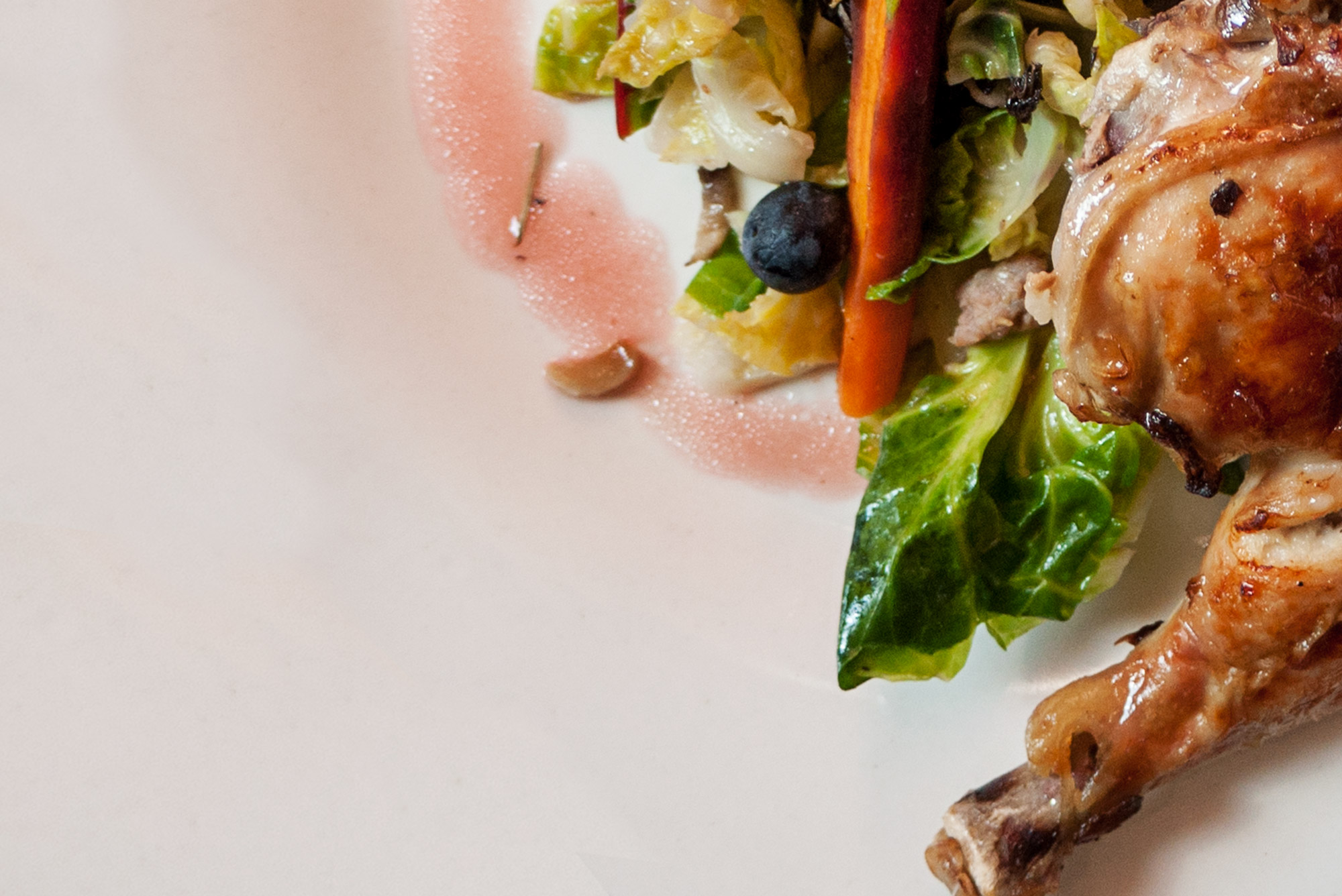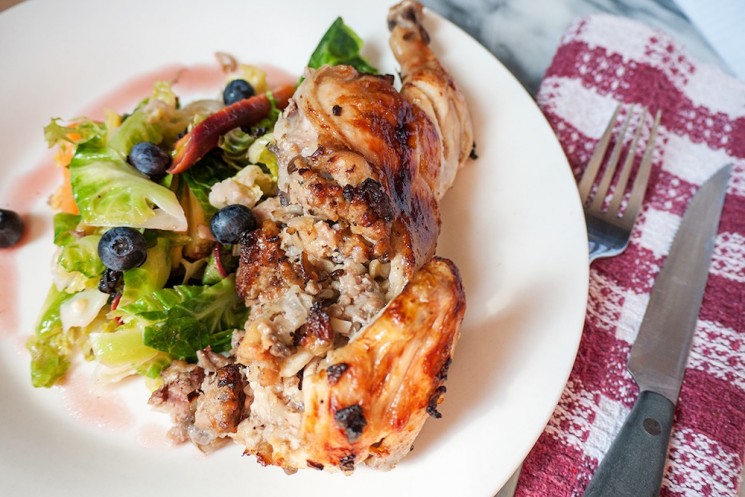
Pigeonneaux Farcis aux Champignons en Ragout
Editor’s Note
Pair this recipe with a light red wine, or even a rosé. Burgundy wines work best for this springtime dish. We opted for a 2011 Macon. Its slight tartness and soft tannins (100% gamay) are a perfect compliment to the slightly gamey flavors of the pigeon or guineafowl.
In 1651, Pierre-Francois de la Varenne published Le Cuisinier François, which remains one of the most celebrated cookbooks of all time, recognized as the first “true French cookbook”. Prior to its publication, recipes were passed down by generations through stories told by grandmothers (cited, to this day, by many chefs as being their first source of culinary inspiration). Given the lack of literacy at the time, recipes were not typically transcribed. Varenne was the first to put into print the culinary innovations achieved during 17th century France. Let us thank Le Cuisinier François for the introduction of many french classics; cooking with butter instead of lard, Béchamel, the mother of all french sauces, and the earliest print recipe for Mille-Feuille.
Sometimes, I wonder, “what would de la Varenne’s recipe be like if he were alive today?” As I sifted through the book, I jotted down some recipes and techniques, and adapted them to create this month’s featured recipe.
Pigeonneaux farcis aux champignons en ragoût
Servis avec salade printanière
Serves 2

1 pigeon, gutted and deboned (your butcher can do that for you. If you’re not comfortable with pigeon, guinea hen is a good substitute.)
1 or 2 raw sausages, flavor of your choice, depending on the size of your pigeon
150 grams of button mushrooms (1/2 box, approx..)
1 big Spanish onion
The pigeon
Open up your bird, you’ll to have to cut the backbone out, crack the ribcage and remove the keel bone.
Place the pigeon breast side down on the cutting board. With the tip of your knife cut from the neck to the tailbone of the bird, sliding down on either side of the backbone.
Remove the backbone, and discard. Flip, then with your hands, break the ribcage by flattening the bird, (visualize opening a book), on the cutting board. A little flat bone will pop up from the rib cage (that’s the keel bone, grab it and discard). Rinse it well, and place it on a large sheet of aluminum foil.
Chop your mushrooms into a duxelle, cut them as small as you can. Melt a big tablespoon of butter (preferably salted and cultured) in a medium pan on medium-high heat, with a tablespoon of vegetable oil.
Dice your onion, and throw it in the pan once the butter starts frothing. Brown your onions lightly, for about 2-3 minutes, then add your mushrooms and sausages. With a wooden spoon, break your meat into small pieces, as if making spaghetti sauce.
Once your stuffing meat is cooked through, place it inside the pigeon, and make sure to push it in well so it’s compact. Take the foil, and wrap it around the bird to close it up. Place it in the oven at 425 degrees, for approximately 25 minutes, on a baking tray.
Then, take it out of the oven, unwrap it from the foil, and place it back on the tray for another 15 minutes, or until golden brown.
Let rest for 5 minutes.
10-12 brussels sprouts
5-6 small carottes nantaises (multicolored carrots)
A small handful of mixed mesclun (could be replaced with simply arugula)
5 tablespoons of cranberry juice
1 tablespoon of balsamic vinegar
150 millileters of vegetable oil.
The salad
Cut your Brussels sprouts and core them by removing the v-shaped stem with a knife. Loosely break the leaves up and throw them in a cold pan.
Remove the skin from the carrots, cut in half lengthwise, and then again on the bias. Scatter them throughout the pan with sprouts, and add cold water. Add salt, and place on the burner on high heat. Once the water starts simmering, take off the water and pass them through a strainer to take out the water.
Place the veggies back in the same pan, and put them on medium high heat with a spoonful of butter. Salt and pepper to taste, and sautée the vegetables in the pan for 2-3 minutes, until light coloration. Place them in a bowl.
Dressing:
In a mason jar, mix together cranberry juice, balsamic vinegar, and of vegetable oil. Add salt, pepper, and sugar to taste, and one herb of your choice (I opted for thyme).
Plate your Meal
Add a bit dressing to the veggies (just enough to coat them) and place in center of the plate.
Once your pigeon has rested, cut it in half. Place on the plate, slightly resting on the salad. Top off the salad with either blueberries or pomegranate seeds, and maybe even a bit of parmesan. Take a spoonful of the vinaigrette and drizzle around the plate for presentation.
Editor's Note
Pair this recipe with a light red wine, or even a rosé. Burgundy wines work best for this springtime dish. We opted for a 2011 Macon. Its slight tartness and soft tannins (100% gamay) are a perfect compliment to the slightly gamey flavors of the pigeon or guineafowl.
In 1651, Pierre-Francois de la Varenne published Le Cuisinier François, which remains one of the most celebrated cookbooks of all time, recognized as the first “true French cookbook”. Prior to its publication, recipes were passed down by generations through stories told by grandmothers (cited, to this day, by many chefs as being their first source of culinary inspiration). Given the lack of literacy at the time, recipes were not typically transcribed. Varenne was the first to put into print the culinary innovations achieved during 17th century France. Let us thank Le Cuisinier François for the introduction of many french classics; cooking with butter instead of lard, Béchamel, the mother of all french sauces, and the earliest print recipe for Mille-Feuille.
Sometimes, I wonder, “what would de la Varenne’s recipe be like if he were alive today?” As I sifted through the book, I jotted down some recipes and techniques, and adapted them to create this month’s featured recipe.
Pigeonneaux farcis aux champignons en ragoût
Servis avec salade printanière
Serves 2

1 pigeon, gutted and deboned (your butcher can do that for you. If you’re not comfortable with pigeon, guinea hen is a good substitute.)
1 or 2 raw sausages, flavor of your choice, depending on the size of your pigeon
150 grams of button mushrooms (1/2 box, approx..)
1 big Spanish onion
The pigeon
Open up your bird, you’ll to have to cut the backbone out, crack the ribcage and remove the keel bone.
Place the pigeon breast side down on the cutting board. With the tip of your knife cut from the neck to the tailbone of the bird, sliding down on either side of the backbone.
Remove the backbone, and discard. Flip, then with your hands, break the ribcage by flattening the bird, (visualize opening a book), on the cutting board. A little flat bone will pop up from the rib cage (that’s the keel bone, grab it and discard). Rinse it well, and place it on a large sheet of aluminum foil.
Chop your mushrooms into a duxelle, cut them as small as you can. Melt a big tablespoon of butter (preferably salted and cultured) in a medium pan on medium-high heat, with a tablespoon of vegetable oil.
Dice your onion, and throw it in the pan once the butter starts frothing. Brown your onions lightly, for about 2-3 minutes, then add your mushrooms and sausages. With a wooden spoon, break your meat into small pieces, as if making spaghetti sauce.
Once your stuffing meat is cooked through, place it inside the pigeon, and make sure to push it in well so it’s compact. Take the foil, and wrap it around the bird to close it up. Place it in the oven at 425 degrees, for approximately 25 minutes, on a baking tray.
Then, take it out of the oven, unwrap it from the foil, and place it back on the tray for another 15 minutes, or until golden brown.
Let rest for 5 minutes.
INGREDIENTS10-12 brussels sprouts
5-6 small carottes nantaises (multicolored carrots)
A small handful of mixed mesclun (could be replaced with simply arugula)
5 tablespoons of cranberry juice
1 tablespoon of balsamic vinegar
150 millileters of vegetable oil.
The salad
Cut your Brussels sprouts and core them by removing the v-shaped stem with a knife. Loosely break the leaves up and throw them in a cold pan.
Remove the skin from the carrots, cut in half lengthwise, and then again on the bias. Scatter them throughout the pan with sprouts, and add cold water. Add salt, and place on the burner on high heat. Once the water starts simmering, take off the water and pass them through a strainer to take out the water.
Place the veggies back in the same pan, and put them on medium high heat with a spoonful of butter. Salt and pepper to taste, and sautée the vegetables in the pan for 2-3 minutes, until light coloration. Place them in a bowl.
Dressing:
In a mason jar, mix together cranberry juice, balsamic vinegar, and of vegetable oil. Add salt, pepper, and sugar to taste, and one herb of your choice (I opted for thyme).
Plate your Meal
Add a bit dressing to the veggies (just enough to coat them) and place in center of the plate.
Once your pigeon has rested, cut it in half. Place on the plate, slightly resting on the salad. Top off the salad with either blueberries or pomegranate seeds, and maybe even a bit of parmesan. Take a spoonful of the vinaigrette and drizzle around the plate for presentation.
